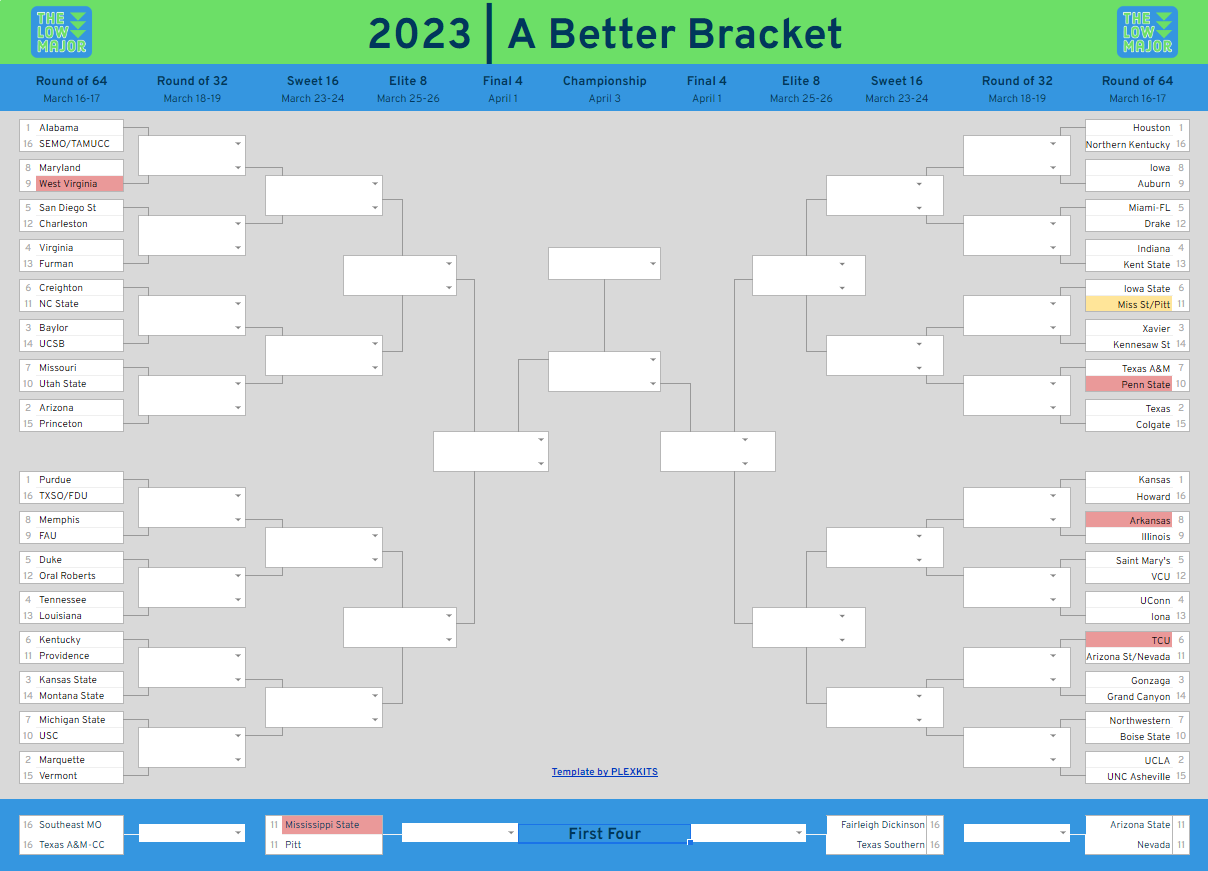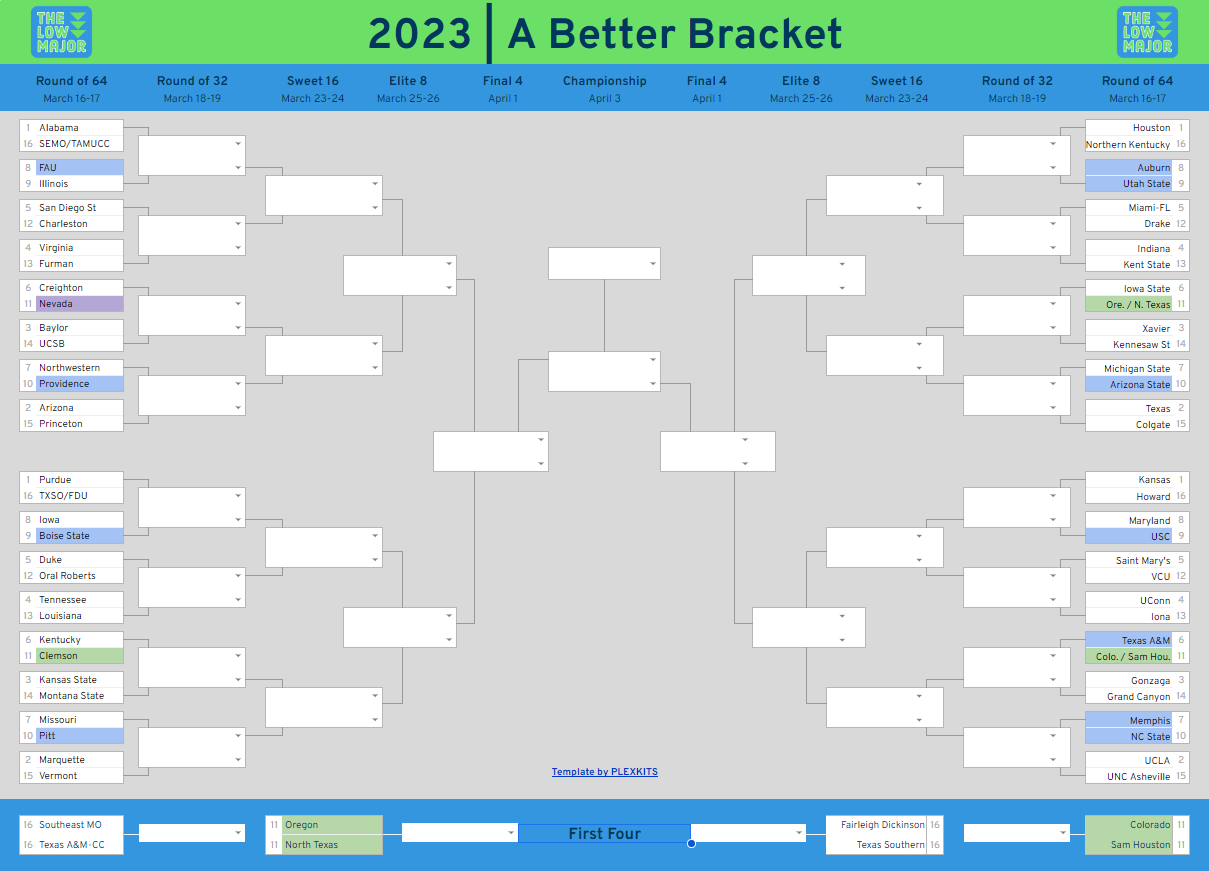A Better Bracket, 2023
We're so back
Last year, Ret and I had an idea, one that would lead to a better bracket for all, a fairer solution to ease the strain of settling who truly deserves the final few at-large selections that are dispensed to 36 lucky winners each year.
In our attempt to make the land of college basketball - and particularly, the NCAA Tournament, more equitable and fairer for all, we landed on the following two rules:
A team must be over .500 in conference play (the NCAA Tournament already mandates that all at-large selections must be over .500 anyways, but does not hold that restriction to conference play specifically).
A team must also finish in the top half of its conference. If there are an odd number of teams, round DOWN. The Big East, for example, with 11 teams, can only send a maximum of 5 teams to the tournament. The Big Ten, with 14 teams, only gets 7 bids.
We do this because we desire a fairer world, one that offers teams that don’t have the same opportunities year-in year-out to compete at the highest level a better shot at making the tournament without needing to win their conference to do so, as opposed to sending a middling power-conference team that limped to a barely-.500 finish.
Much like last year, now that the 2023 bracket is here, we’re going to examine the field and make adjustments to correct for the rules we’ve set. We won’t be taking automatic bids away from anyone - they earned those fair and square. This is solely about at-larges.
Here’s the bracket. Teams highlighted in red would be the ones eliminated under our new system.
Packing Their Bags
[6] TCU
The Big 12 is scarily deep this year, and unfortunately, that puts the Horned Frogs on the outside looking in, the first of two Big 12 teams cut - with only 5 available bids and 7 teams in the field, two have to go home.
[8] Arkansas
The Hogs are technically inside the SEC’s team limit - the 7th of 8 teams in, with 7 allotted bids. It’s the conference record that sinks them, an 8-10 mark not good enough to escape my watchful eyes. For them, unfortunately, there will be no dancing this year.
[9] West Virginia
Much the same as their conference brethren, the Mountaineers are eliminated by the half-conference rule. Unlike TCU, West Virginia did not manage to go .500 during conference play, and as such would also be eliminated by this rule.
[10] Penn State
Penn State falls just shy - two points - of securing the Big Ten autobid, and unfortunately, that proves all the difference, as they sit as the eighth and last Big Ten team in the field. With the Big Ten having 14 teams, they get 7 bids - and the Nittany Lions are the odd group out.
[11] Mississippi State
The Bulldogs run into the unfortunate situation that West Virginia found themselves in - not only are they the odd team out by numbers, the conference record leaves them on the outside looking in with no way to get back in front.
This, of course, leaves us five open spots. As much as I’d like to shove my five favorite teams in there and call it square, we do need to adhere to structure - and there are plenty of teams left on the outside looking in.
How do we determine who gets these last five bids?
First point: no teams from the Big Ten, the SEC, or the Big 12 can make it in. All three of those conferences have hit their team threshold. Sorry, Rutgers. Do better next year.
From here, we’ll run down the NIT seedlines to pull our teams, ignoring, as stated, teams from the above three conferences as well as any teams that did not attain a .500 conference record.
Two teams, Dayton and North Carolina, elected to not pursue any additional postseason opportunities when it was clear they were not part of the NCAA Tournament field. While I can’t necessarily fault them for that choice, it does mean that they will be rendered de facto ineligible for a replacement bid, though both would have been eligible otherwise.
Of our NIT 1-seeds, two are ineligible: Rutgers and Oklahoma State, who are in the Big Ten and Big 12 and thereby outside the half-conference limit. Two are eligible, though, and we’re happy to add them into the fold. The first is Clemson, the ACC’s 6th team in. The second is Oregon, who comes in as the Pac-12’s 5th bid.
That’s two of our five replacements found. We go to the NIT 2-seeds now. Of these, three are ineligible: Wisconsin and Vanderbilt of the Big Ten and SEC, respectively, and therefore outside the half-conference limit, and New Mexico, whose 8-10 conference mark in Mountain West play stymies their chances at a bid. This leaves one bid to be settled, and it falls into the hands of Conference USA’s North Texas, joining Florida Atlantic as the second team from CUSA.
This leaves two bids yet to be sorted, so we go onwards. There are three three-seeds eligible, so we’ve hit our goal. The fourth is Michigan, another casualty of a terrifyingly stacked Big Ten.
Of the three teams, I’m going to pick two by rule of cool - one is Liberty, and anyone who knows me knows I loathe Liberty with every fibre of my being (and if you want to know more about why, Cam Newton's stunning op-ed from 2019 and my own piece from 2020 should illuminate plenty about why supporting the Flames is abhorrent).
This leaves Colorado, the Pac-12’s sixth and final bid, and Sam Houston, who sneaks in as the WAC’s second - despite Utah Valley taking the NIT autobid, interestingly - but with it, we have our five replacement teams.
As such, the bracket now looks like this:
Teams in green are new to the field, teams in blue have moved up a seed line, and our one team in purple is dear Nevada, who didn’t escape their seed line but did float out of the First Four.
You might say “but, David, you’ve just traded spades for spades - more than half of those teams are power-conference squads” - and you’d be right. It’s a shame that at the end of the day there’s a distinct edge given to those who have power and money and strength as opposed to those who don’t - but if we don’t at least consider ways to change the systems of power that we exist underneath, then why bother advocating for anything at all?
Minor change is better than no change, and I gotta tell ya - the idea of seeing a bid fall into the hands of North Texas (4 all-time tournament appearances) or Sam Houston (2 all-time Division I appearances) is so much more exciting to me. It’s the beginning of a change that would, to me, perpetuate a systemic shift towards a better, fairer, and truer bracket.





